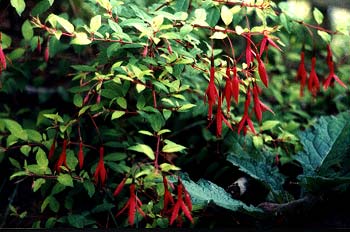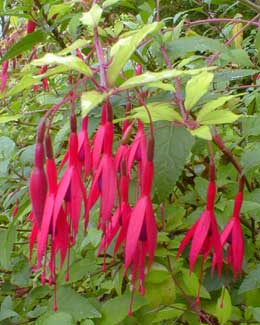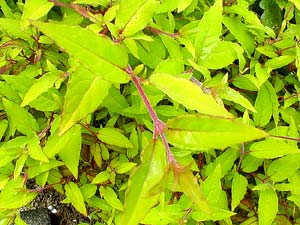
Golden Fuchsia
"Merry it was: about him sung the birds,
The spring flowers bloom'd along the firm, dry road,
The sleek-skinn'd mothers of the sharphorn'd herds
Now for the barefoot milking-maidens low'd."
-William Morris
(1834-1896)
(1834-1896)
 Fuchsia magellanica gracilis 'Aurea' or Golden Fuchsia has red flowers with purple corollas within, & red stems with small golden or yellow-green leaves.
Fuchsia magellanica gracilis 'Aurea' or Golden Fuchsia has red flowers with purple corollas within, & red stems with small golden or yellow-green leaves.The leaves are their richest golden yellow in early spring, before flowering. The leaf portrait below, from May, shows it at its most extreme. The leaves darken to yellow-green or even green as the year progresses, as in the first photo (snapped in August). The second photo(from October) captures a lot of dark green foliage from a nearby 'Winchester Fanfare' Cape Fuchsia; only the narrower yellow-green leaves are from 'Aurea,' still a fairly striking contrast to surrounding green leaves even though not as richly golden as before 'Aurea' is blooming.
The pre-bloom golds of the foliage are almost like a separate early spring flowering, & by the time it is no longer intense in its leaf color, the bright red blooms have arrived to keep this subshrub colorful.
Granny Artemis bought this as a tiny very pretty start in a three-inch pot & planted it at the foot of a columnar hornbeam tree, where it gets considerable dappled sunlight. It will thrive in either partial sun or dappled shade, but the golden effect of the leaves is stronger in more light, as it will become greener in shade.
Here in the Pacific Northwest it can tolerate full sun, just so long as the soil is never permitted to dry out. In warmer zones it is a matter of guesswork & gambling to find it the most sun it can stand for the maximum golden-leaf effect, without scorching it.
 In its somewhat sunny location our little start in its first year grew quickly to two or three feet tall with some of its long stems nodding in wide fountaining sweeps, covered the full length in dangling blossoms by August & still in full amazing bloom in November.
In its somewhat sunny location our little start in its first year grew quickly to two or three feet tall with some of its long stems nodding in wide fountaining sweeps, covered the full length in dangling blossoms by August & still in full amazing bloom in November.In 2003, after it was well established, it bloomed beginning late May. It is extremely common in our zone that this variety blooms until Autumn's end, the flowers lasting even through mild frosts.
The redness of the stems & leaf veins heightens in Autumn. It has an evergreen presence all winter, & the previous year's leaves still looked great in May, though not as fresh & perfect as the new growth, & it can be pruned for looks or compactness to one's individual liking.
After it is fully budded by late April or early May, it becomes easy to tell which limbs are going to bloom best. That's the time when old limbs can be pruned to remove whatever was most winter-damaged or appears to be worn out or dry. Ours in its first year called for almost no pruning, but most springs since it has been necessary.
Ours has grown partially prostrate so that some of the flowers actually lay horizontal on the ground from the lowest branches. But it also sends some of its branches upward to three feet height or higher, mostly at long fountaining angles, with flowers dangling all along the sweep of the branch. It might look even more stunning if planted from a rocky ledge where even the lower branches dangled in air, but on ledges there'd be the potential of excessively good drainage drying the soil too rapidly, when it likes to stay moist.
Akin to the less hardy hanging-basket fuchsias, this golden-leafed variety can benefit by a monthly liquid fertilizer during its blooming period, tapering off to no more fertilizer in autumn.